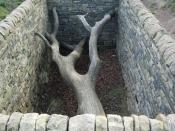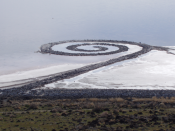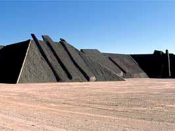During the 1960s, Conceptual art was a growing trend in postwar art. The political strife of that time, as well as the increasing political attacks on the institution that contributed to it, were reflected in the art world's increasing ambivalence towards its own institutional traditions--that is, the long-standing bourgeois paradigm of art. The Land Art movement, which began in the United States, emerged from this 1960s art world as a response to the heightened political activism of the time and the emerging environmental and women's liberation movements.
Although resistant to being seen as part of any distinct movement, the first major Land Art artists--Michael Heizer, Robert Smithson, Robert Morris--all seem to have been dramatically influenced by these socio-cultural currents of the time. They all agreed that sculptural art could have a life away from the institution, out in the world, inflected by a variable and organic location. Many of these artists had at first been involved with Minimalism and Conceptual Art, but had later become disillusioned with gallery-bound art.
Robert Morris, for example, worked for a few years as a minimalist, creating simple geometric forms, and eventually went in a direction that led to concerns about process, formlessness, and chance.
Later into the 1960s, Morris and Smithson both started proposing projects that involved 'earthwork', which were extremely large works that took place out in the environment. In his well-known work, Spiral Jetti, Smithson constructed a spiral in the Utah landscape made of mud, rocks, and salt crystals. In a similar spirit, Michael Heizer used bulldozers to dig lines in the desert landscape. These works were eventually "displayed" in the Virginia Dwan Gallery. Much of the Earthworks exhibition consisted solely of photographic documentation of works that were either destroyed or simply unmovable and in distant locations. Though these works were displayed...


